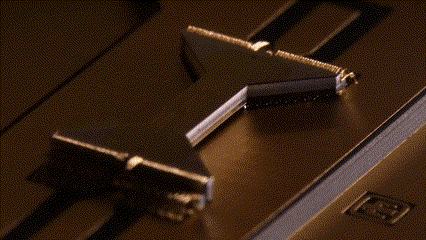Sandia Lab has developed a new ion trap, the Enchilada Trap, a crucial component for specific quantum computers. This device could potentially support up to 200 qubits, allowing for more complex quantum algorithms to be run. The Enchilada Trap will be used at both Sandia and Duke University, with the latter being a research partner through the Quantum Systems Accelerator.
Despite the advancement, a quantum computer with up to 200 qubits will not outperform a conventional computer for solving useful problems at current error rates. However, it will enable researchers to test an architecture with many qubits that in the future will support more sophisticated quantum algorithms for physics, chemistry, data science, materials science and other areas. The team at Sandia has been researching, building and testing ion traps for 20 years, and the Enchilada Trap represents a combination of institutional knowledge and new innovations.
Sandia Develops New Ion Trap for Quantum Computing
Sandia Lab (Sandia National Laboratory), a research and development company, has created its first batch of a new ion trap, a crucial component for certain quantum computers. This new device, known as the Enchilada Trap, allows scientists to construct more powerful machines, contributing to the experimental yet potentially transformative field of quantum computing.
The Enchilada Trap is a type of microchip that holds electrically charged atoms, or ions. The more ions, or qubits, that can be trapped, the more complex the algorithms a quantum computer can run. With the right control hardware, the Enchilada Trap could store and transport up to 200 qubits using a network of five trapping zones.
However, according to Daniel Stick, a scientist at Sandia, a quantum computer with up to 200 qubits and current error rates will not outperform a conventional computer for solving useful problems. It will, however, allow researchers to test an architecture with many qubits that could support more sophisticated quantum algorithms in the future.
Partnership with Duke University
Several of these traps will be utilised at Duke University for performing quantum algorithms. Duke and Sandia are research partners through the Quantum Systems Accelerator, one of five U.S. National Quantum Information Science Research Centres funded by the DOE Office of Science. This partnership aims to advance the field of quantum computing and explore larger machines and more complex programming.
Design Challenges and Innovations
To overcome a series of design challenges, the team at Sandia combined institutional knowledge with new innovations. They needed space to hold more ions and a way to rearrange them for complex calculations. The solution was a network of electrodes that branches out similar to a family tree or tournament bracket. Each narrow branch serves as a place to store and shuttle ions.
The Enchilada Trap uses the same design in a tiled way so it can explore the scaling properties of a smaller trap. The team believes the branching architecture is currently the best solution for rearranging trapped ion qubits. It anticipates that future, even larger versions of the trap will feature a similar design.
Addressing Electrical Power Dissipation
Another concern was the dissipation of electrical power on the Enchilada Trap, which could generate significant heat, leading to increased outgassing from surfaces, a higher risk of electrical breakdown and elevated levels of electrical field noise. To address this issue, production specialists designed new microscopic features to reduce the capacitance of certain electrodes.
Looking Ahead
The team at Sandia is always looking ahead, collaborating with scientists and engineers to learn about the kind of technology, features and performance improvements they will need in the coming years. They then design and fabricate traps to meet those requirements and constantly seek ways to further improve. This forward-thinking approach is crucial in the rapidly evolving field of quantum computing.
“We are providing the field of quantum computing room to grow and explore larger machines and more complicated programming,” Daniel Stick, a Sandia scientist and leading researcher with the Quantum Systems Accelerator.
“Our team is always looking ahead,” said Sandia’s Zach Meinelt, the lead integrator on the project. “We collaborate with scientists and engineers to learn about the kind of technology, features and performance improvements they will need in the coming years. We then design and fabricate traps to meet those requirements and constantly seek ways to further improve.”
Summary
Sandia has developed a new ion trap, named the Enchilada Trap, which could potentially support up to 200 qubits, a significant advancement in the field of quantum computing. Despite current error rates, this development allows for the testing of more complex quantum algorithms, paving the way for future advancements in physics, chemistry, data science, materials science and other areas.
- Sandia National Laboratories has developed a new ion trap, named the Enchilada Trap, which can support up to 200 trapped ion qubits, a key component for certain quantum computers.
- The device will be used at both Sandia and Duke University, with whom Sandia is partnered through the Quantum Systems Accelerator, a research centre funded by the U.S. Department of Energy Office of Science.
- The Enchilada Trap can store and transport qubits using a network of five trapping zones, a design inspired by its predecessor, the Roadrunner Trap.
- Despite the increased qubit capacity, Sandia scientist Daniel Stick notes that a quantum computer with up to 200 qubits will not outperform a conventional computer for solving useful problems at current error rates. However, it will allow researchers to test more sophisticated quantum algorithms in the future.
- The design of the Enchilada Trap includes a network of electrodes that can store and shuttle ions, and new microscopic features to reduce the capacitance of certain electrodes, addressing concerns about heat generation and electrical field noise.
- Sandia’s Zach Meinelt, the lead integrator on the project, emphasises the team’s forward-looking approach, collaborating with scientists and engineers to anticipate future technology needs.
Read More

